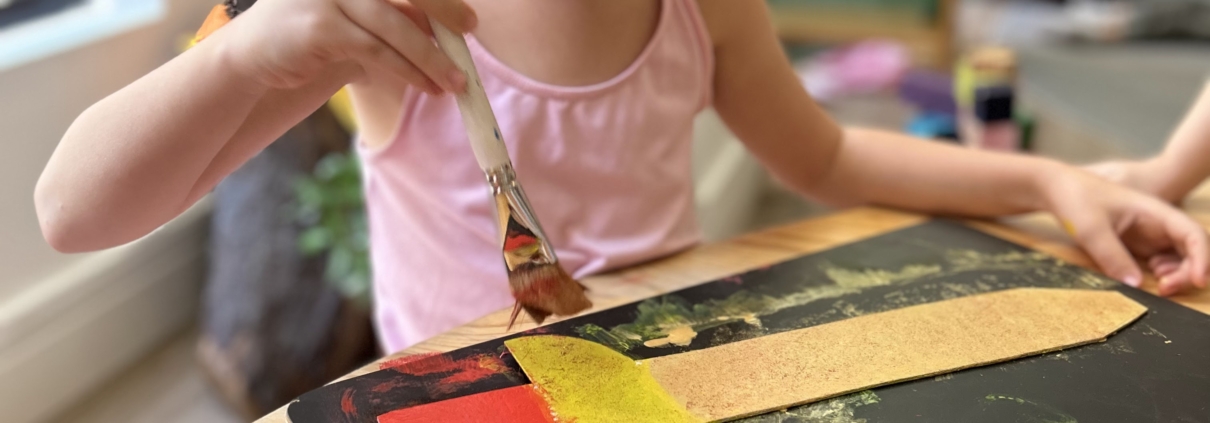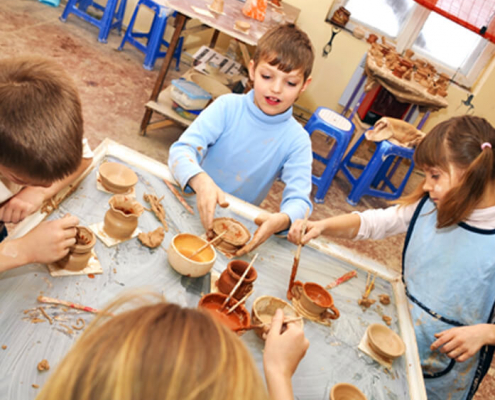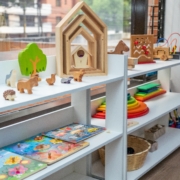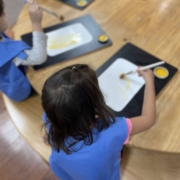Nurturing Your Child
By Carrie Riley
I would like to share information on Waldorf philosophy and ways we can reinforce the rhythms at home.
Rhythm
Rhythm- is structure, it is what brings order out of chaos and we all know how chaotic life can be with young children.
When we provide a rhythmical day for the little ones it brings them a sense of security in the knowing, a sense of well-being, relaxation, and a sense of accomplishment.
There is a yearly rhythm that is reflected in the seasons and a time to experience a feeling of community as we come together to enjoy the different feelings that nature provides throughout the year. There is a monthly rhythm with the waxing and waning of the moon. Women get to experience a monthly rhythm for more than half their lives. There is a weekly rhythm and daily rhythm that provides structure to our work life, family life, and social life. It is the daily rhythm that affects the children most.
In Waldorf education when we look to create a rhythm for the children we look to format it in terms of an in and out breath. The in-breath is a more formal or contained part of the rhythm whereas the out-breath is the moment you can let it all go. This is happening because our lives have changed and we have two working parents trying to get out the door by a certain time the morning is a big IN breath for the children, so by the time they come to school they need an OUT breath which can happen during free play with active play, then for circle, IN breath, then OUT breath with the HUG shop, then snack IN breath etc.
Breathing is rhythmical and it is the basis of life. If we move through the day this way we are teaching the children at the very core of their being how to live life in a healthy and balanced way. Plus it makes your life much easier. When they know the rules and what to expect they are much more likely to cooperate.
Think of rhythm as the structure of the home, walls, ceiling, floors, windows, and the fluctuations of the day are all the decorations inside. You get to redecorate your home every day; I know it leaves us all in constant amazement at how different one day can be from the other. Here are some ideas of how you can provide rhythm in your home.
- Sleeping– try to put your child to bed at the same time every night. Have a simple routine that is just for those moments before bed. It helps them to know what is coming and what is expected of them. Lights in the bedroom come on when it is time for you to get up, if not on, it’s not time, go back to sleep.
- Meals – try to have meals be at a similar time and place each night. Again have some type of ritual, lighting a candle, a song, a verse. Be clear with your expectations with your child. Do they need to sit until everyone is finished etc. Think about those things and stick to them. Your life will be easier when they become teenagers. Snacks when and how.
- Playtime, etc.
- Clothing– Where are their shoes kept, jackets, what can they do by themselves? Create a rhythm of expectations before leaving the house. Do they need to keep their hat on?
- Cleaning – toys and pick up, when they need to be picked up?
Much of it has to do with how your family’s day looks and how you can make certain moments in the day predictable and the same.
Tools for supporting your child’s behaviors
(i.e. do not give too many choices)
Rhythm is supported by firm boundaries with the young child. Again creating form and structure for them makes them feel safe. A young child does not want to be in charge. They don’t want to be the ones making decisions. When a child is asked if they want to eat now or would you like to put on a jacket it creates a lot of anxiety for the child. They want and need authority. Of course, we want to approach this in a loving way. First, we say “You may put on your shoes now.” or “It’s time for me to put on your shoes now.” Adding a bit of imagination works wonders. “ come to the shoe shop” if a child is not wanting to put on their shoes, as this is common for most at some point, we can approach this with, “I will put on your shoes or you may do it”.
Table
You may sit until we are all finished with dinner. Repeat until the child understands, it may take time and that is okay. By providing children freedom within the container you create they will feel safer and can trust the world more. Don’t worry there will be plenty of time for them to be the decision maker.
Nutrition
Nutrition has a huge impact on behavior. Everything from cooperation to sleep, to mood, and most importantly health. This time of year we are all very interested in keeping our children healthy and free from as many colds and flu and we can make it possible. Nutrition is key in the prevention of sickness.
Providing nutrient-dense foods that are packed with vitamins, minerals, and healthy fats. Non-processed, whole, and if possible organic foods. One of the most important foods to avoid is sugar. When researching what amount of sugar is okay for young children, it was very difficult to find a recommended amount. Then I found out why when I came across a site that said no amount of sugar is okay for a young child. So no one wants to commit to an okay amount because there is no amount that is okay. With that in mind…and the reality that we live in a world full of sugar. Grandparents give it, aunties and uncles give it and sometimes we even use it to bribe our children. However, we can do our best to reduce the amount as much as we can. So begin to find the hidden sugars in your child’s life. For example: 1 t is 4.7 gms of sugar so when a child eats one of those healthy organic fruit yogurts that has 18 grams of sugar you are giving them just under 4 teaspoons of sugar. Then we put a half-sliced apple in there which is about 11 grams of sugar so just over 2 teaspoons of sugar. Then a peanut butter and jelly sandwich anywhere from 11 to 18 grams so another 2-4 teaspoons. What happens to a child when they eat sugar? It spikes their blood sugar for a time. Then they crash, it activates their endorphins and adrenals, which over-stimulates the child. When there is a lot of sugar in the blood, which in layman’s terms, is digested by the white blood cells and reduces the white blood cells’ ability to absorb any viruses or foreign agents in the body by 75% for 4-6 hours. If sugar is a must always couple it with protein to help reduce the blood sugar spike. Books say sugar is the cause of obesity not fat. Also, sugar keeps the immune system at risk. Give lots of good fat (nuts, avocado, olive oil, animal fats) to your kids for brain and organ development. And keep them warm, less sugar and more warmth with lots of sleep will help keep sickness at bay.
Warmth
Speaking of warmth, it is very important to keep your children warm. We speak of warmth in the Waldorf world on several levels: physical warmth, environmental, and emotional warmth. It is an absolute necessity for a growing, thriving child. This time of year in colder climates, however, physical warmth is at the forefront. Keep your babies warm. Even though a child’s temperature can often run higher than adults, children don’t have a developed enough system yet to maintain that heat, so they chill much faster than we do. They also don’t have the body awareness to understand when they are feeling cold, even up to 7 years old they may not understand that they are cold. When they get cold the body is using up its energy that should be going to maintain the immune system, developing organs, building the body and the brain for keeping the child warm so they survive. We don’t want our children to be in survival mode. Those need to be taken care of by us so they can be free to grow and develop. There are two rules of thumb used to gauge your child’s warmth.
- Are their hands and feet cold? If so there is not enough warmth in the body’s core to heat the extremities. Put on more clothes. But if they are warm, it does not necessarily mean they are warm enough.
- If you need two layers your child needs three. Always an extra layer than what you find you need. Do not make the mistake of asking your child if they are warm enough. They do not have the capacity of body knowledge yet to determine this adult body awareness. Remember to touch their hands and feet.
It’s important to use natural materials like silk, wool, or cotton. Organic cotton clothes are important for your baby because you really want to limit their irritants and exposure to chemicals when they’re developing. This will not only keep them healthier and help them develop more naturally, but it will also keep them a lot more comfortable due to limiting the irritants around them.
Thank you for taking the time to understand a little bit more about Waldorf education, rhythm, and warmth.














